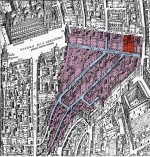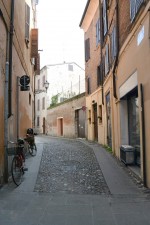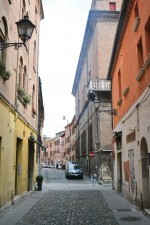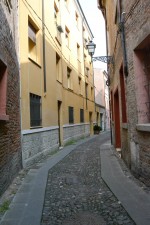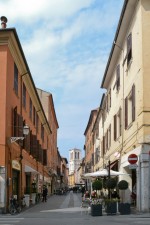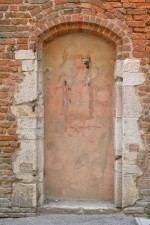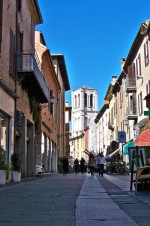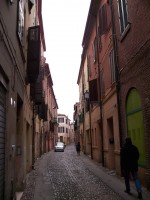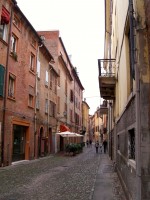Ghetto gates in Via Mazzini
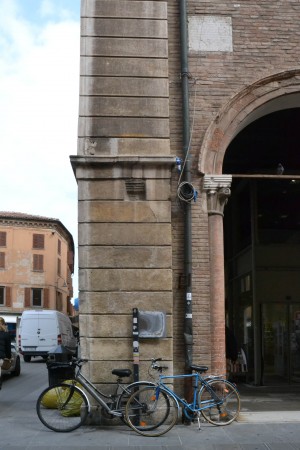
At the end of Via Mazzini towards today's Piazza Trento e Trieste, where one of the gates of the ghetto was. Photograph by Edoardo Moretti, 2015. © MuseoFerrara
The gates of Via Mazzini are the most impressive of the five built in 1627; they delimited the main street of the ghetto, were closed at dusk and marked the separation of the Jewish Community from the rest of the city in the Papal Age.
1. Introduction: the Edict and the construction of the gates
As a result of the Edict of 13 August 1624, the Jews, who had long been concentrated between Via Sabbioni (now Via Mazzini), Vignatagliata and Gattamarcia (now Via Vittoria), were isolated within an area delimited by five gates: two in Via Sabbioni (one on the side of Via Saraceno, the other towards the current Piazza Trento and Trieste); two in Via Vignatagliata (before the junction with San Romano and on the border with Via Contrari), one at the end of Via Gattamarcia, before reaching today's Via Ragno. As soon as the news broke, the presidents of the Jewish Community appointed a Commission of twelve notables, including Rabbi Bonajuto Alatino, to intercede with the cardinal legate so that the ghetto would not be built. However, they could only postpone for a few years: the gates, to be closed during the night and from Thursday to Holy Saturday, were placed in 1627, at the end of the works directed by the Community architect Ercole Morandi.
2. The gate of Via Mazzini
The two main gates are the marble ones in Via Sabbioni, of good architecture and with side doors for those who, with regular permission, must leave before opening or return after the established closing time. First demolished upon the arrival of French troops in 1796, the gates were closed after the fall of Napoleon and again demolished several times during the nineteenth century, until the definitive dismantling with the annexation of Ferrara to the Kingdom of Italy in 1861. Even today, on the side of Via Mazzini of the loggia of San Crispino, you can see the wrought iron hinges of the door of Via Sabbioni, and those of the door of Via Vittoria, on the side overlooking Via Ragno.
3. Quotes
"The Jews, who before were not forbidden to live in the city promiscuously with Christians, but who nevertheless for the convenient communication between them, and the proximity of the square had been reduced to the houses of the streets of Sabbioni, Gattamarcia, Vignatagliata, and others adjoining, in this year [1624] in their defence, and to better contain them under the supervision of the government [...] they were [...] locked up, through five gates at the heads of the named streets, and so was formed that neighbourhood that was called the Ghetto. The two main streets of Via de’ Sabbioni presented two noble perspectives all of soda marble and beautiful architecture, which were then landed and cut into pieces by the French on April 9, 1797" (Frizzi 1848, V, pp. 77-78).
"In 1624 under the Pontificate of Urban VIII, the Jews of Ferrara were ordered to no longer live scattered in the various parishes of the city, but to concentrate on the Via Sabbioni and three others very close to it, and that large gates were erected at the ends of these districts to keep them closed evening until the following morning. […] until 1626, according to Mgr. Mannina [sic] Ferranti, and until 1627, according to Frizzi, the closure did not take place, and this was carried out at the expense of the Jews through 5 large doors at the ends of the Mentovata districts, with architectural embellishments in those of Via Sabbioni, [...] in which the width of the street also opened side doors, in order to give entry and sortie to those, who, behind permission, had to return to the Cloister later or to leave before the established time " (Pesaro ed. 1986, pp. 37-39).
"The current Via Mazzini, popularly called the ‘Ghetto’ even today [1918], truly and only includes the Ghetto of the Israelites (a word that means separation). [...] in 1624, by order of p[ope] Urbano VIII, Card. Legato Giacomo Serra, ordered that the Jews, dwelling in number of 1530 in the streets of Sabbioni, Gattamarcia (Vittoria) and Vignatagliata, with the consent of Bishop Card. Giambattista Leni and the Magistrate, were enclosed, through five gates to the heads of the named streets, and separated from the Christians! The Neighbourhood, called the Ghetto, remained so formed. The two doors of Via dei Sabbioni presented two beautiful marble perspectives of elegant architecture, with doors, which were locked in the evening and reopened, the sun rising. Those gates were smashed to pieces by the French on 9 August 1797. Restored to their place on 8 May 1833 by the municipal authority by order of Pope Gregory XVI, in the last year of Archbishop Filonardi, they were again and forever overthrown by the fury of the people on the evening of 21 March 1848. And a civil legend finally came out to proclaim those people equal in rights, as in duties, to Christians" (Melchiorri 1918, pp. 126-127).
Bibliography
- Chiappini, Alessandra, Immagini di vita ferrarese nel secolo XVII in La chiesa di San Giovanni Battista e la cultura ferrarese del Seicento, Electa, Milano 1981
- Pesaro, Abramo, Memorie storiche sulla Comunità israelitica ferrarese, rist. anast. dell'edizione Ferrara 1878-1880, Forni, Sala Bolognese (Bologna) 1986
- Melchiorri, Gerolamo, Bassi, Carlo, Nomenclatura ed etimologia delle piazze e strade di Ferrara. Ampliamenti all'opera di Gerolamo Melchiorri, 2G, Ferrara 2009
Fototeca
Related Themes
Related places
Related Events
Related Itineraries
Compiling entity
- Istituto di Storia Contemporanea di Ferrara
Author
- Edoardo Moretti
- Sharon Reichel

